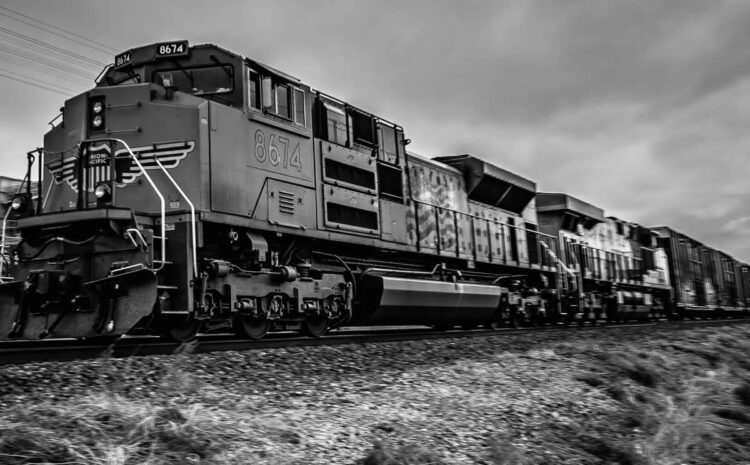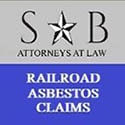
Asbestos, a naturally occurring mineral known for its durability and heat-resistant properties, has a dark history as a hidden danger in various industries, including the railroad sector. In this exploration, we delve into the nature of asbestos, its pervasive use in the railroad industry, and the heightened risk of exposure faced by individuals who worked in this sector before the regulatory changes in 1982.
Understanding Asbestos
Asbestos is a group of six naturally occurring minerals with thin, microscopic fibers. These fibers are resistant to heat, fire, and chemicals, making asbestos a desirable material for various industrial applications. Historically, asbestos found its way into construction, shipbuilding, automotive, and, notably, the railroad industry due to its exceptional insulation properties.
The six types of asbestos minerals are chrysotile, amosite, crocidolite, tremolite, anthophyllite, and actinolite. Chrysotile, commonly known as white asbestos, was the most widely used type and was frequently employed in the railroad industry.
Asbestos in the Railroad Industry
The railroad industry, a cornerstone of transportation, heavily relied on asbestos for its unique attributes. Asbestos was extensively used in locomotives, passenger cars, and infrastructure components. The following are key areas where asbestos was prevalent:
1. Locomotives and Brake Systems:
Asbestos was a common component in locomotives, particularly in the brake systems. Brake linings and pads were often made with asbestos due to its heat resistance and frictional properties. As trains applied brakes, the friction generated heat, and asbestos effectively dissipated it, making it an ideal material.
2. Insulation:
Railroad components required insulation to protect against extreme temperatures. Asbestos, with its exceptional insulating properties, was used in various insulation materials found in steam engines, boilers, and pipes throughout the railroad infrastructure.
3. Gaskets and Seals:
Asbestos-containing gaskets and seals were prevalent in the railroad industry, used in engines, pumps, and other machinery to prevent leaks. The durability and resistance to heat made asbestos an attractive choice for these components.
Increased Risk of Exposure in the Railroad Industry
The widespread use of asbestos in the railroad industry exposed workers to the mineral’s harmful fibers, putting them at an increased risk of developing asbestos-related illnesses. This risk was particularly pronounced for individuals who worked in the industry before regulatory measures were implemented in 1982. Several factors contributed to the heightened exposure risk:
1. Lack of Awareness:
Before the dangers of asbestos became widely known, there was a lack of awareness regarding the health risks associated with asbestos exposure. Workers in the railroad industry were often uninformed about the potential hazards they faced while handling or working in close proximity to asbestos-containing materials.
2. Prolonged Exposure:
Railroad workers were routinely exposed to asbestos over extended periods. Maintenance tasks, repairs, and replacements involving asbestos-containing materials were common occurrences. Prolonged exposure increased the likelihood of inhaling asbestos fibers, leading to a higher risk of developing asbestos-related diseases.
3. Inadequate Protective Measures:
Before the implementation of stricter regulations, protective measures to mitigate asbestos exposure were often inadequate. Workers did not have access to proper respiratory protection or safety protocols, further amplifying their risk of inhaling asbestos fibers during routine tasks.
The repercussions of asbestos exposure within the railroad industry have resulted in a spectrum of debilitating illnesses, encompassing asbestosis, lung cancer, mesothelioma, throat cancer, stomach cancer, and esophageal cancer. Asbestosis, a chronic lung condition stemming from the inhalation of asbestos fibers, leads to the scarring of lung tissue and compromised respiratory function. Additionally, lung cancer and mesothelioma, both aggressive cancers linked to asbestos exposure, are joined by throat cancer and esophageal cancer in the array of health issues associated with the detrimental impact of asbestos. Mesothelioma, in particular, affects the lining of not only the lungs but also the abdomen or heart, further underscoring the widespread and severe consequences of asbestos exposure in the railroad industry.
Asbestos, once hailed for its versatile applications, has left a legacy of health hazards in the railroad industry. The pervasive use of asbestos in locomotives, insulation, and various components exposed workers to a hidden danger that has had enduring consequences. Individuals who worked in the railroad industry before 1982 face an increased risk of developing asbestos-related illnesses due to prolonged exposure, inadequate protective measures, and a lack of awareness regarding the dangers of asbestos. Recognizing the historical context and the risks involved is crucial in understanding the impact of asbestos in the railroad sector and working towards better health and safety practices in industries still grappling with the aftermath of this silent threat.
Asbestos Trusts: Financial Assistance for Victims
In the wake of the widespread asbestos-related illnesses, various companies faced legal action, leading to the establishment of asbestos trusts. These trusts were designed to provide financial compensation to victims and their families affected by asbestos exposure. As of the latest available information, billions of dollars have been set aside in these trusts to assist those suffering from the devastating consequences of asbestos-related diseases.
The specific amount allocated to asbestos trusts is dynamic, as it depends on the number of claims and the financial status of each trust. As of my knowledge cutoff in January 2022, estimates suggest that the total amount across all asbestos trusts exceeds $30 billion. These trusts were established by companies that filed for bankruptcy due to asbestos-related liabilities, and they serve as a crucial lifeline for victims seeking compensation.
Sammons & Berry P.C.: Advocates for Asbestos Victims
Among the legal firms dedicated to assisting asbestos victims, Sammons & Berry P.C. stands out as a compassionate and experienced team committed to helping individuals collect the compensation they are due from asbestos trusts. The firm has a proven track record of successfully representing clients in asbestos-related cases, ensuring that victims receive the financial support they need during challenging times.
Expertise and Experience:
Sammons & Berry P.C. boasts a team of seasoned attorneys with extensive expertise in asbestos litigation. Their knowledge of the intricate legal processes surrounding asbestos claims positions them as effective advocates for victims seeking rightful compensation from asbestos trusts.
Personalized Approach:
Recognizing the unique circumstances of each case, Sammons & Berry P.C. takes a personalized approach to legal representation. They understand the nuances of asbestos exposure in various industries, including the railroad sector, and tailor their strategies to address the specific challenges faced by their clients.
Comprehensive Assistance:
Navigating the complexities of asbestos trusts can be daunting for victims and their families. The team at Sammons & Berry P.C. provides comprehensive assistance throughout the claims process. From gathering essential documentation to filing claims and ensuring compliance with trust requirements, they guide clients at every step to maximize their chances of receiving fair compensation.
Maximizing Compensation:
Sammons & Berry P.C. is dedicated to maximizing the compensation their clients receive. Through diligent case preparation, negotiations, and leveraging their understanding of trust processes, the firm aims to secure the highest possible settlements for victims. Their commitment extends beyond legal representation to addressing the broader needs of individuals affected by asbestos-related diseases.
How Sammons & Berry P.C. Can Help You:
If you or a loved one has been diagnosed with an asbestos-related illness, seeking the assistance of Sammons & Berry P.C. can make a significant difference in your pursuit of compensation. The firm’s experienced attorneys will:
Evaluate Your Case: Conduct a thorough assessment of your case to determine eligibility for asbestos trust claims.
Navigate Trust Requirements: Guide you through the intricate requirements of various asbestos trusts to ensure compliance and maximize your chances of success.
File Claims: Prepare and submit claims on your behalf, streamlining the process and minimizing the burden on victims and their families.
Advocate for Your Rights: Vigorously advocate for your rights and interests, leveraging their expertise to secure fair compensation from asbestos trusts.
In conclusion, the financial assistance available through asbestos trusts represents a crucial resource for victims of asbestos exposure. Sammons & Berry P.C. stands as a dedicated ally, offering the legal expertise and support needed to help individuals collect the compensation they rightfully deserve. By choosing experienced advocates like Sammons & Berry P.C., victims can navigate the complexities of asbestos trust claims with confidence, knowing that they have a committed team working tirelessly on their behalf.
Starting Your Compensation Journey
Embarking on the journey towards compensation as a retired railroad worker on the East Coast is a pivotal step toward securing justice for the health risks you’ve endured. To initiate this process, we invite you to call our dedicated team at (800) 519-1440. Sammons & Berry, P.C. is poised to provide personalized assistance, ensuring that your case is handled with the utmost care and expertise. Your well-being and pursuit of justice are our top priorities.
Determining Your Eligibility for Compensation
Retired railroad workers on the East Coast may wonder if they qualify for compensation. The answer lies in understanding the specific circumstances of your asbestos exposure. Our legal team is well-versed in the criteria for eligibility and can assess your case thoroughly during the consultation. If you have concerns about your eligibility or simply wish to explore your options, our team is ready to provide the guidance and information you need.
Our commitment to retired railroad workers on the East Coast is not just a professional duty; it’s a promise to stand with you through every aspect of your compensation journey. From the initial consultation to the successful resolution of your claim, Sammons & Berry, P.C. is dedicated to ensuring that justice is served and that you receive the compensation you rightfully deserve.
See if you qualify for compensation
Sammons & Berry, P.C.
800-519-1440
View our Google Listing
View our Facebook


